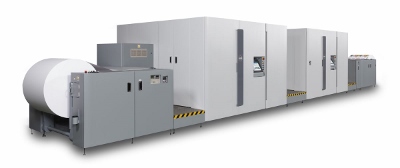The new Océ ImageStream 3500.
Timed to coincide with a two-week long customer event at the former Océ facility in Poing near Munich, and with the staging of Fespa Digital 2014 taking place in Munich at the same time, Canon has announced a swathe of new and future printing technologies across high speed continuous feed, cut sheet production, and wide format digital sectors.
The Canon for Business 2014 event took place at the same location as the Océ Open House once did, and attracted some 2600 customers from around the world. Technological highlights included the launch of the light production imagePress C800 Series with 70 and 80 pages per minute machines; a high speed inkjet system – the Océ ImageStream 3500 – that can print onto offset coated paper stocks (available from the beginning of 2015); the Océ VarioStream 4000 Series of black and white dry toner continuous feed presses alongside new entry level VarioStream 7110/7170 models (also mono and continuous feed); and a preview of a new cut sheet inkjet press still in development, thus far called ‘Project Niagara’, which Canon claimed will fill the gap between cut sheet and entry level continuous feed production.
The imagePress 800 Series is due to ship from July 2014. It is aimed at customers with a duty cycle of 20,000 to 100,000 sheets per month, and can print at full speed (80 pages per minute) on media up to 220 gsm, while being able to handle media up to 300 gsm at lesser speeds. The system is packed with new technology to improve quality and flexibility. This includes the new Consistently Vivid (CV) toner, improved registration and colour calibration tools, and a 32-beam VCSEL laser unit that delivers 2400 x 2400 dpi resolution. There is a choice of front end technology, including a Prisma-based one, and EFI Fiery-based options, either embedded or external, using the new Fiery FS150 platform, which Canon is the first to use.
On the continuous feed side, Canon said it has already sold its first ImageStream 3500 – a 30-inch wide inkjet system that is capable of printing at up to 160 metres (525 feet) per minute at 1200 x 600 dpi. This uses a new pigment ink set that has been optimised for use with standard offset coated media.
‘The Océ ImageStream rivals the speed and image quality of offset technologies, such as conventional B2 presses, while harnessing the capabilities of digital printing technology for shorter runs, print-on-demand and variable data,’ said Peter Wolff, director of Canon Europe’s Commercial Printing Group.
Shown at the Canon for Business event only as a conceptual video, Project Niagara was described as a ‘game changer’, by David Preskett, Professional Print director for Canon Europe, although it will be late 2014 and into 2015 before the press is launched. Canon is working with five customers in Germany and the Netherlands on its development. It is a cut sheet inkjet press that is intended to suit companies producing two to three million prints per month (it can print up to 300 A4 images per minute). Inkjet technology from the Océ ColorStream has been used in its build. It takes media up to B3 size, specifically to match up with much finishing equipment.
Canon’s intention is to bring the advantages of continuous feed inkjet – namely, speed and low consumable cost – into cut sheet. Standard offset coated and uncoated papers can apparently run on the technology, due to a new water-based ink formulation. It is currently a CMYK press but with two further stations for additional colours possible. Canon said the running costs would make it possible to use it for both colour and black and white output from one system.
A wide format announcement was left until the first day of Fespa Digital, with the literal unveiling on the Canon stand of the Océ Arizona 6100 Series of flatbed printers. This is designed for productive rigid media output, said Canon, being capable of operating at speeds of up to 155 square metres per hour (it is 2.5 times faster than the next fastest Arizona machine). The flatbed table size of 2.5 x 3.05 metres can be used as a single vacuum table for large prints, or be split into two independent printing zones, allowing simultaneous printing and media loading. The drop size of the ink can be varied between 6 and 42 picolitres, and substrates up to 50 mm thick can be printed upon.



